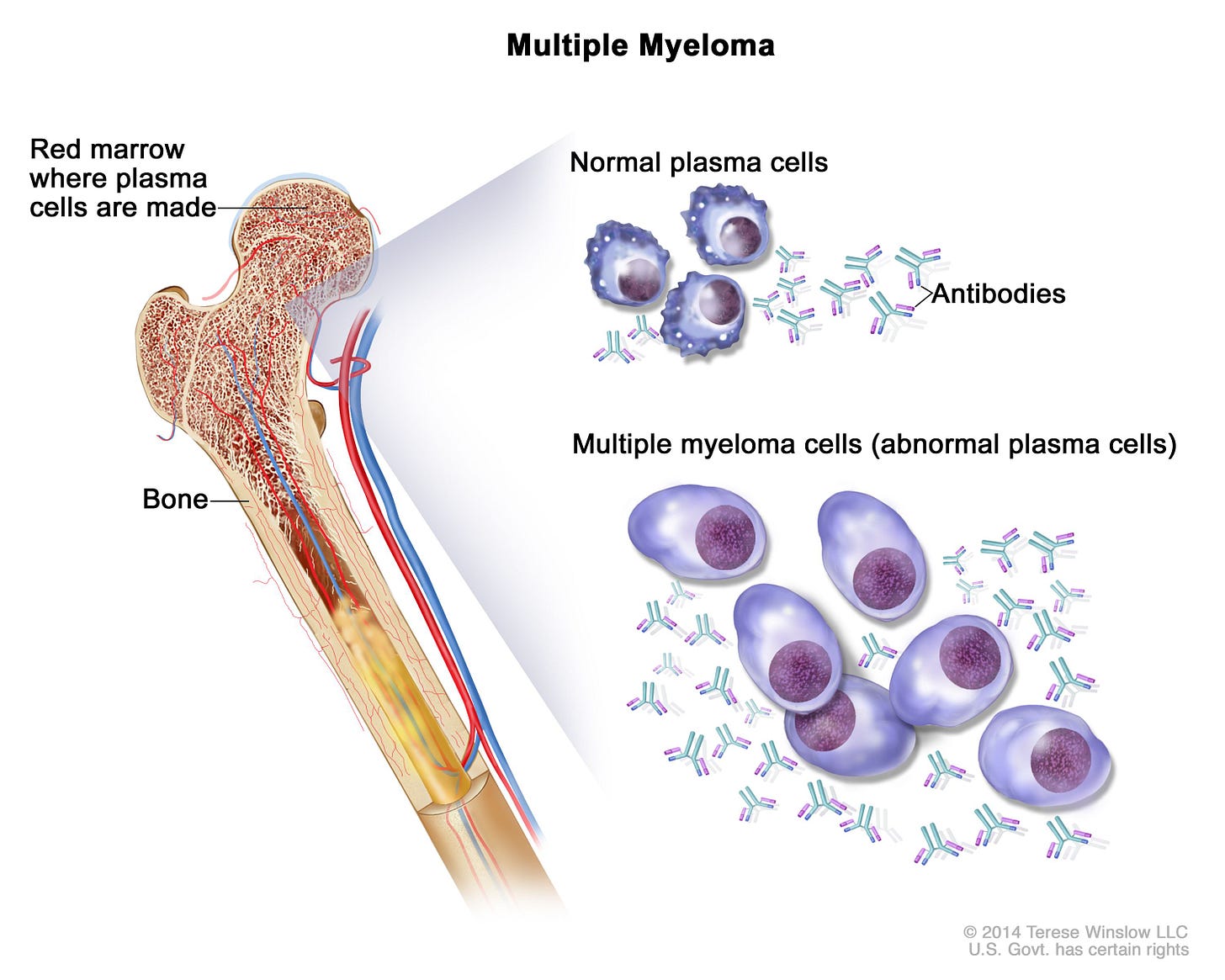What is Multiple Myeloma?
Written by Aarushi Rai
Multiple Myeloma is a cancer that forms in plasma cells, which are a type of white blood cell. Plasma cells are very important because they help fight infections by making antibodies/proteins. The bone marrow is the soft matter inside bones where blood cells are made, and the cancerous plasma cells build up inside the bone marrow and essentially replace healthy blood cells. Additionally, the myeloma cells attempt to make antibodies themselves (like the healthy cells they replaced), but they create monoclonal (M) proteins instead. These also build up in the body and cause complications such as kidney damage. Like all cancers, what begins with one healthy plasma cell turns into a myeloma cell, which makes more cancer cells much more rapidly than regular cells are created.
It is not clear what the exact cause of Multiple Myeloma is. Scientists have figured out, though, that it starts as the condition Monoclonal Gammopathy of Undetermined Significance, or MGUS. It causes an excess of immunoglobulins, or protein molecules, in the blood, but it does not cause any symptoms nor need treatment. Every year, 1 in 100 people with MGUS develop Multiple Myeloma, meaning it is not entirely uncommon, but there is no way to prevent or delay it from happening other than getting regular checkups for possible cancer. Additionally, the stages of Multiple Myeloma go from stage 1, meaning it is growing slowly, to stage 3, meaning it is rapidly advancing.
Symptoms of Multiple Myeloma can vary, but it includes persistent bone pain and weak, easily-fractured bones, tiredness, hypercalcemia (having high levels of calcium in the blood, which can lead to even more complications), and more. In addition, the disease can cause multiple complications, such as infections, anemia (having a low red blood cell count), kidney problems like kidney failure, etc. The diagnosis of Multiple Myeloma can be done through urine tests to see if M proteins show up, bone marrow tests (like a biopsy or aspiration), or blood tests. Lastly, treatment for it isn’t always needed. If no symptoms show, doctors may recommend doing continuous tests to watch the myeloma in case it gets worse, but if symptoms do show, treatment can begin with medicine, which can vary. Some examples include an anti-myeloma medicine to destroy the cancer cells or control them if they return, CAR-T (Chimeric Antigen Receptor T Cell Therapy) cell therapy, chemotherapy, targeted therapy, immunotherapy, and more. If it works, a bone marrow transplant can also be used.
References
Multiple myeloma - Symptoms and causes - Mayo Clinic. (2024, July 30). Mayo Clinic. https://www.mayoclinic.org/diseases-conditions/multiple-myeloma/symptoms-causes/syc-20353378
Multiple myeloma - Diagnosis and treatment - Mayo Clinic. (2024, July 30). https://www.mayoclinic.org/diseases-conditions/multiple-myeloma/diagnosis-treatment/drc-20353383
Website, N. (2023, November 6). Multiple myeloma. nhs.uk. https://www.nhs.uk/conditions/multiple-myeloma/
Written by Aarushi Rai from MEDILOQUY


